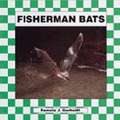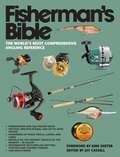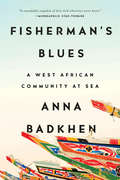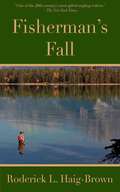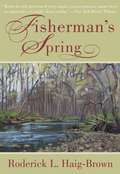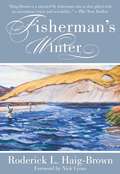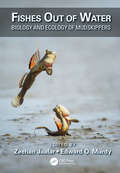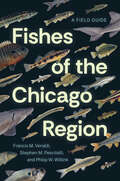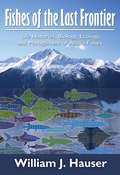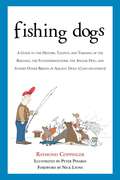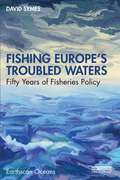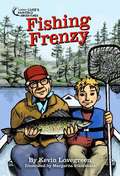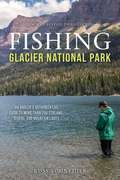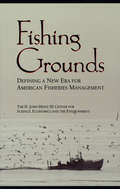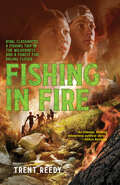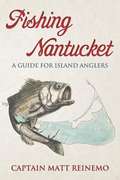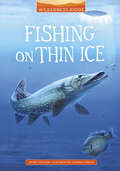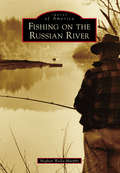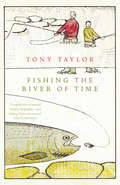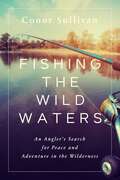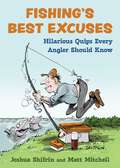- Table View
- List View
Fisherman Bats (Bats)
by Pamela J. GerholdtWhat are fisherman bats? Where do they live? How big are they? Find out all about the characteristics, habitat, and behaviors of the Fisherman bat.
Fisherman's Bible: The World's Most Comprehensive Angling Reference
by Jay Cassell Kirk DeeterIn the tradition of the bestselling Shooter's Bible, Skyhorse Publishing presents the Fisherman's Bible, the most complete reference guide for new fishing equipment and their specifications. Now, anglers will only need one book to discover all the new gear on the market as well as lookup specs on accessories currently in production.A comprehensive full color feature on new products includes large photographs of every rod, reel, and lure with extensive product details and feature listings. In addition to the latest gear, the Fisherman's Bible offers thousands of rods, reels, lures, and lines that have been in production and are currently on the market. All products are divided into freshwater and saltwater, and further separated by spin, spincasting, baitcasting, and flyfishing. Nearly every fishing gear manufacturer in the world is included in this unique compendium.With an introduction highlighting the hottest new products on the market, as well as timely features on such informative topics as new trends in fishing, a beginner's guide to fishing, and what and where to fish: popular species and prevailing methods, the Fisherman's Bible is an essential authority for any beginner or experienced angler, wherever he or she may live or choose to fish.
Fisherman's Blues: A West African Community at Sea
by Anna BadkhenAn intimate account of life in a West African fishing village, tugged by currents ancient and modern, and dependent on an ocean that is being radically transformed.The sea is broken, fishermen say. The sea is empty. The genii have taken the fish elsewhere.For centuries, fishermen have launched their pirogues from the Senegalese port of Joal, where the fish used to be so plentiful a man could dip his hand into the grey-green ocean and pull one out as big as his thigh. But in an Atlantic decimated by overfishing and climate change, the fish are harder and harder to find. Here, Badkhen discovers, all boundaries are permeable--between land and sea, between myth and truth, even between storyteller and story. Fisherman's Blues immerses us in a community navigating a time of unprecedented environmental, economic, and cultural upheaval with resilience, ingenuity, and wonder.
Fisherman's Fall
by Roderick L. Haig-BrownOriginally published in 1964, Fisherman's Fall brings a unique perspective to the world of fall fishing. In the preface, Robert L. Haig-Brown ruminates on the attempts to preserve the salmon and trout in the rivers of British Columbia. What we know could save them, yet what we do contradicts that knowledge. Gaining the knowledge in this book will help fishers learn the nature of the fish and might even inspire some to contribute to their preservation.Fisherman's Fall gives fishers all the tools to become adept at fishing the rivers of British Columbia as well as firsthand knowledge of the fish of those rivers and their habits. In fabulous prose, readers will discover the unique fishing facts and techniques that accompany the fall season, differences between salmon in salt water and fresh water, the ocean years of salmon, the nature of estuaries, steelhead mysteries, and what makes an ideal stream.Besides gathering wise information, readers get to glimpse the inner thoughts of a fisherman in the chapters of Haig-Brown's own thoughts while fishing. These wise words will speak to any fisher, and they will even speak to those who have never been on a river. Combining angling advice and inner reflection, this book is a must-have for fishermen and fisherwomen of all ages.
Fisherman's Spring
by Nick Lyons Roderick L. Haig-BrownOne of the most prolific fly-fishing writers of the twentieth century, Roderick L. Haig-Brown continues his "seasons" cycle with Fisherman's Spring, a book that is as much about the deep philosophical aspects of fly fishing as it is about fly fishing itself. Readers will learn about the abundance of spring life in the streams of British Columbia while also being treated to Haig-Brown's thoughtful musings and ideas about the rewards of fly fishing streams. Chapters readers will encounter include:Spring DefinedEarly Cutthroat LakesFly TypesThe Secret LifeFishing and the Common ManOn WadingFishermen and ForestryFishing and MilkmaidsThe ForecastRecognizing BirdsPutting Fish BackA Boy and a Fish PoleAnd many moreDiscover within these pages how fly fishing can enrich life and bring joy to every fisher. Both novices and experts alike will find a wealth of knowledge in Fisherman's Spring.
Fisherman's Winter
by Nick Lyons Roderick L. Haig-BrownOriginally published in 1954, Fisherman's Winter is Roderick Haig-Brown's final installment in his well-known "seasons" cycle. With a unique blend of experience and observation, Haig-Brown brings readers through the exotic
Fishes Out of Water: Biology and Ecology of Mudskippers (CRC Marine Science)
by Zeehan Jaafar Edward O. MurdyMudskippers are amphibious fishes native to the Indo-West Pacific and tropical western Africa. Unlike most fishes, mudskippers emerse to forage, find mates, and defend territories. Adaptations to their morphology, physiology and behavior enable mudskippers to accommodate both aquatic and terrestrial habitats. For these traits, mudskippers have long captured the fascination of scientists, naturalists, and fish hobbyists. Some mudskipper taxa (e.g. Periophthalmodon spp., Periophthalmus spp., Boleophthalmus spp.) are readily observed on mudflats and mangrove forests during the ebb tide. Correspondingly, these conspicuous and widespread taxa are relatively well-studied. The autecology and basic biology for the remaing taxa (e.g. Apocryptodon spp. and Oxuderces spp.) are still poorly understood. Fishes Out of Water: Biology and Ecology of Mudskippers is the first comprehensive book to synthesize published scientific information and observation on these fishes. Two dozen subject experts present thorough overviews in fifteen distinct chapters. Contents span mudskipper anatomy, distribution, systematics, physiology, ecology, and conservation. Unique adaptations to terrestriality are discussed within the context of each chapter foci. This authoritative reference equips the reader with the basic foundation to understand mudskipper biology and ecology, while providing a framework in which emerging data are discussed. The book will be of interest to a broad range of students, researchers, and professionals in ichthyology, evolution, ecology, animal behavior, and comparative physiology.
Fishes of the Chicago Region: A Field Guide
by Francis M. Veraldi Stephen M. Pescitelli Philip W. Willink“A treasure of hardcore fish intelligence and delightful tidbits of fish history.”—Dale Bowman, Chicago Sun-Times Fish don’t heed state boundaries, and neither does this comprehensive, photo-filled guide to the diverse species of Chicago and beyond. Encompassing southern Lake Michigan, northeastern Illinois, and adjacent areas of Indiana, Michigan, and Wisconsin, the Chicago Region is home to rare habitats supporting diverse fish populations. From small creeks to large rivers and from small ponds to one of the world’s largest freshwater ecosystems, Lake Michigan, these systems are home to some 164 fish species representing 31 families. In this essential field guide, the most complete and up-to-date reference for fishes in the Chicago Region, we meet them all—lampreys, sturgeon, paddlefish, gars, drum, darters, perches, sticklebacks, sculpins, and more. Written by leading local ecologists and featuring a pictorial family key, color photographs, detailed species distribution maps, and natural history observations unique to the region, this go-to guide belongs on the shelf—and in the boat—of every angler, naturalist, fisheries manager, and biologist.
Fishes of the Last Frontier: Life Histories, Biology, Ecology, and Management of Alaska's Fishes
by Bill HauserFishes of the Last Frontier answers many of your fish questions and others you haven't even thought of yet in a nontechnical, plain talk voice. Learn about the fishes that are of value or special interest to Alaskans: how fish are able to survive and grow, how they get along with each other--or not--and what they eat, where and how our Alaska fishes spawn, the difference between a red and a redd, and the difference between anadromous and catadromous and why that is important. The author, a fishery scientist with nearly 50 years of experience and training, including more than 30 years in Alaska, describes the life history characteristics of 43 species of fishes valuable or important in some way to Alaskans. He delves into various aspects of biology and ecology of fish and provides insight into how humans and fish interact. The processes of fishery management in Alaska are described. Fishes of the Last Frontier includes fishes from throughout Alaska in fresh, brackish, and marine waters and sport, commercial, and subsistence fisheries. Learn not just how anadromous fish find their way home but also how scientists were able to learn the details. Nontechnical readers have reported the presentations as enjoyable, understandable, and informative.
Fishing (Boy Scouts of America Merit Badge Series)
by Boy Scouts of AmericaThis pamphlet will tell you a lot about fish and how to catch them. You might catch them for fun and "sport," or to eat. Fishing can become a lifetime pursuit, like golf or tennis. Many kinds of fish are described here, along with many ways to catch them--there are always new challenges in fishing, and always more to learn. This is one merit badge you are sure to enjoy earning from the very start. Robert S. S. Baden-Powell, the founder of the Scouting movement, offers this advice to the young fisherman: "Every Scout ought to be able to fish in order to get food for himself. A tenderfoot [beginner] who starved on the bank of a river full of fish would look very silly, yet it might happen to one who had never learned to catch fish." It's no surprise that fishing remains a favorite pastime on Scout outings.
Fishing Activity Book for Kids: 50 Creative Projects to Inspire Curious Anglers
by David LisiGet kids hooked on fishing with fun activities for ages 8 to 12Fishing is so much fun, and it's an awesome skill to have! This book is filled with hands-on activities that teach kids everything they need to go fishing, from choosing their line and setting up their rig to properly casting their rod and safely removing hooks. They'll learn all about tackle and proper fishing techniques—as well as patience and respect for Mother Nature.This fishing book for kids can help them:Locate the best fishing spots—Young anglers will find out how to "read" water and nature to detect fish in freshwater areas like lakes, ponds, reservoirs, rivers, and streams.Get creative and think outside the box—Kids will explore exciting DIY activities like making their own fishing rod, fly tin, sinkers and snaps, water clarity tester, and more.Discover fishing tips and fun facts—Tons of fascinating fishing facts and pointers help kids stay engaged and safe.Inspire kids to become fishing pros with the Fishing Activity Book for Kids.
Fishing Dogs: A Guide to the History, Talents, and Training of the Baildale, the Flounderhounder, the Angler Dog, and Sundry Other Breeds of Aquatic Dogs (Canis piscatorius)
by Raymond Coppinger Nick Lyons Peter PinardiIf you're familiar with the world of hunting, you know how important dogs are in the field. Less known, however, is how vital these canines are to fishermen. For many anglers, packing your tackle and wading through the river without a trusted fishing dog is a recipe for disaster.In Fishing Dogs, Raymond Coppinger sheds light on the true value of fishing dogs of every size, shape, and color. Monsoon dogs, for example, lay in the bilge of boats until they are disturbed by the shipping of water. At that point, they rise up out of the bilge and unleash with tremendous power a series of epicentric rotational reciprocations, thus expelling inches of boat-threatening water. Coppinger also introduces readers to the Maine bowplunk dog, which received its name from its deeply ingrained habit of standing, proud and brave, on the bow of his master's boat as it moves through the choppy waters off Maine's coast.As a biologist, distinguished fisherman, and a known storyteller and fan of satire, Coppinger is more than qualified to discuss the various breeds of fishing dogs, in addition to topics as the evolution of dogs from wolves, the dangers of crossbreeding, and finding a fisherman's perfect fishing dog.
Fishing Europe's Troubled Waters: Fifty Years of Fisheries Policy (Earthscan Oceans)
by David SymesSpanning the last 50 years of fisheries policy in Europe, this book is the parting contribution and career-spanning reflection from one of Europe’s most renowned social scientists working in the field of fisheries management and policy. The last 50 years have without doubt been the most turbulent years in the history of North Atlantic fisheries – a turbulence brought about by the actions of fishers, scientists and above all politicians. It is a period of change that sees a radical redrawing of the political geography of fisheries, globalisation of trade, the development of fisheries management towards increasingly restrictive regulation, and declining fish stocks. The book explains why the bold but deeply flawed Common Fisheries Policy persistently failed to deliver its basic goal of sustainable fisheries. The spotlight falls on the monolithic, highly centralised, command and control nature of the Policy that strives to apply a universal ‘one size fits all’ approach, thus creating a governing system wholly unsuited to the system to be governed, out of kilter with preferred models of governance, and disconnected from the practical realities of fishing as a livelihood in a challenging environment. A final section on Brexit focuses on its halting progress from concept to reality, the implications for the fisheries sector and the fateful final negotiations with the EU over the fisheries question. Seeking to explain why the anticipated benefits for the UK industry failed to materialise, attention is drawn to the misplaced political hubris over regaining ‘sovereignty’ in areas like the North Sea. This book will be essential reading for students, scholars, professionals and policymakers working on fisheries, marine governance, natural resource management, environmental policy and the European Project.
Fishing Frenzy (Lucky Luke's Hunting Adventures)
by Kevin Lovegreen James Monroe Design Red Ink Writing Editing Margarita SikorskaiaJoin Luke and his family on a wild fishing adventure in the Canadian wilderness. This trip has it all: a moose mess, a motor mishap, atomic splashing. There's even a bear intruder. And of course the walleye put on an unforgettable fishing frenzy and Grandpa and Crystal hook the fish of a lifetime
Fishing Glacier National Park: An Angler's Authoritative Guide to More than 250 Streams, Rivers, and Mountain Lakes
by Russ SchneiderFishing Glacier National Park includes over 250 fishing locations from Waterton Lake to the Flathead River. This guide uncovers streams and lakes for Kokanee salmon, mountain and lake whitefish, arctic grayling, and trout--lake, brook, rainbow, and cutthroat. Novice as well as expert anglers will find that the trails and roads in Glacier lead to more than spectacular vistas--many of them lead to great fishing sites.
Fishing Grounds: Defining A New Era For American Fisheries Management
by Economics, and the Environment The H. John Heinz III Center for ScienceFisheries management today is highly contentious. The interests of fishers and fish processors, coastal communities, the government, and environmental organizations are often different and can even be mutually incompatible.Fishing Grounds offers a comprehensive assessment of the legal, social, economic and biological context of marine fisheries management in the United States. Drawing on interviews with stakeholders from all sides of the issue, the authors seek common ground -- and points of unresolved controversy -- among the diversity of interests and viewpoints involved. Chapters examine: history and background status of marine fisheries fishery productivity from biological, social, and economic perspectives ownership of fishery resources management structures and incentives the roles of science and evaluation Each chapter begins with legal, technical, and conceptual background to help readers understand the sets of issues involved and follows that with a balanced presentation of stakeholder views.Fishing Grounds presents a useful overview of fisheries management options and positions regarding those options, providing valuable insight into the opinions and concerns of stakeholders and the sets of incentives to which those stakeholders respond. It is an important work for fisheries management professionals in industry, government agencies, and nongovernmental organizations, as well as for students and researchers involved with fisheries and fisheries management.
Fishing Guide: Fishing Skills You Need (Field & Stream)
by T. Edward Nickens The Editors of Field & StreamCatch all of the fishing information from The Total Outdoorsman Manual in one value-priced edition—from one of the most trusted outdoor sports brands. With practical advice for fly-fishing, baitcasting, spinning and even noodling, this handy guide offers over one hundred hints on gear, knots, boating, and finding where even the stealthiest fish are hiding. Fishers from the dedicated weekend angler to summer dabblers rely on Field & Stream for the best insider information, and this book delivers.In this guide, you’ll learn how to:Harvest nature’s bait shopFly cast upside-downScale a fish with bottle capsMake fish fried riceSet any anchor, anytimeWin the toughest fish fightTake a jaw-dropping fish photoAnd much more
Fishing In Fire (McCall Mountain #0)
by Trent ReedyA wildfire threatens to turn a fishing trip deadly for a group of friends in this high-stakes adventure set in the American wilderness. Things are tense for the middle schoolers in McCall, Idaho, so when Annette Willard suggests a fishing trip, Swann Siddiq, Kelton Fielding, and Hunter and Yumi Higgins all jump at the chance to get away from the drama. The group ventures out into the Idaho woods to Annette’s favorite river spot. But with the other four coupling off, Yumi quickly feels like she’s the only one catching fish, not feelings. Letting the others stay behind, Yumi makes her way home when she runs into Swann’s rival, McKenzie Crenner, and her friends—and instantly connects with professional fisher Mason Bridger. But when they spot smoke rising in the woods between town and their fishing spot, they realize there’s a forest fire raging—and closing in on them. The two friend groups must put aside their feud and work together if they’re going to get out of the forest alive.
Fishing Nantucket: A Guide for Island Anglers
by Matt Reinemo"Reinemo's Fishing Nantucket is the definitive journal on fishing the Island. He covers every aspect of the sport from where, when, how, with what - species by species and month by month. The priceless information is dead on and extends far beyond the shores of Nantucket and even New England. Laced with fun fishing 'tails', this will become a fishing 'how-to' classic that every angler will need for his library. "- Spider Andresen, Publisher, Salt Water Sportsman, Retired. Fleet Captain Margaritaville Marine. In this informative guide, Captain Matt Reinemo provides a species by species analysis of fishing around Nantucket Island. From the basic starting points of where to go and what to use, to details like the precise placement of your lure along a rip's edge, Fishing Nantucket is packed with information to help you catch more fish. More than just a technical how-to, Captain Matt offers anecdotal stories and observations about fishing and his hometown. Whether you are a beginner in search of your first fish, an experienced angler visiting the island, or a seasoned local fisherman, Fishing Nantucket offers something for everyone.
Fishing in Contested Waters
by Sarah KingAfter the Supreme Court of Canada's 1999 Marshall decision recognized Mi'kmaw fishers' treaty right to fish, the fishers entered the inshore lobster fishery across Atlantic Canada. At Burnt Church/Esgenoôpetitj, New Brunswick, the Mi'kmaw fishery provoked violent confrontations with neighbours and the Canadian government. Over the next two years, boats, cottages, and a sacred grove were burned, people were shot at and beaten, boats rammed and sunk, roads barricaded, and the local wharf occupied.Based on 12 months of ethnographic field work in Burnt Church/Esgenoôpetitj, Fishing in Contested Waters explores the origins of this dispute and the beliefs and experiences that motivated the locals involved in it. Weaving the perspectives of Native and non-Native people together, Sarah J. King examines the community as a contested place, simultaneously Mi'kmaw and Canadian. Drawing on philosophy and indigenous, environmental, and religious studies, Fishing in Contested Waters demonstrates the deep roots of contemporary conflicts over rights, sovereignty, conservation, and identity.
Fishing on Thin Ice (Wilderness Ridge)
by Art CoulsonJimmy Benge is excited to celebrate his thirteenth birthday with an ice fishing adventure in northern Minnesota. He's even allowed to invite his best friend, Ryan, to spend winter break at the family’s lakeside home. The two boys learn a lot about ice fishing and catch a few panfish but decide to fish for something bigger: Northern pike, the alpha predators of the lake. The trip is fun until one day, while out fishing by themselves, the boys are hit by a sudden, unexpected snowstorm and find themselves fishing on thin ice.
Fishing on the Russian River (Images of America)
by Meghan Walla-MurphyThe Russian River tells a rich story of Sonoma County, both historically and ecologically. For as long as can be remembered, there has been an intimate relationship between the people of the Russian River and the fish, specifically the salmon and the steelhead. This tale of fishing begins with the Pomo people's communal fishing forays, winds through Russian exploration and early American settlement, and lands in the present time. For millennia, fishing has been a cultural cornerstone on the Russian River. Unfortunately, this once lively and productive salmonid fishery is dying. Overfishing, gravel mining, increased sedimentation from logging and agriculture, dams, and overdevelopment along the riverbanks and tributaries have all caused a decline in salmonid numbers. Thankfully, through collaborative efforts of local residents, nonprofit organizations, ranchers, farmers, and government agencies, fish populations are rebounding.
Fishing the River of Time
by Tony TaylorAt age eighty, Tony Taylor journeys from Sydney, Australia, to British Columbia to fish the Cowichan River with his eight-year-old grandson, Ned. The trip is an opportunity for Tony to return to a landscape that has had a profound effect on his life and his way of thinking, and to share this place with his grandson. As Tony teaches Ned the patient art of fly-fishing, a lifetime of memories, thoughts, and stories unspool in peaceful reflections by the water's edge. Fishing the River of Time is an elegant meditation on nature, life, and family, written with warmth and wisdom. It inspires self-reflection and an appreciation of the natural world and the fundamentals of our human experience. It is destined to become a classic work of simple living in the mold of Henry David Thoreau's Walden.
Fishing the Wild Waters: An Angler's Search for Peace and Adventure in the Wilderness
by Conor SullivanFrom the azure waters of Hawaii to the pristine streams in Alaska to the craggy New England coast, a devoted angler reveals the agony and ectasy of fishing.Fishing the Wild Waters invites us to traverse America and visit three distant and distinct dream destinations for any serious angler—and anyone who aspires to someday become one. Sullivan's marvelous debut illuminates the often profound nature of fishing as a vehicle that connects those who practice it with reverence to a world beyond the one humans created. As we travel along with Sullivan, he reveals what goes into the pursuit of select fish in the region with humor and personal stories as well as deep knowledge. Hawaii, Alaska and New England are some of the last frontiers of fishing in America. They are full of danger, big fish, and extraordinary adventure. To fish these places is to reach back and stand alongside the First Nations of fishermen—our ancestors who lived there for thousands of years before us—as well as those early Americans who built this country using species like cod as their currency. These cultural and fishing outposts will tell us something if we can just be quiet and listen. To hear that message requires an intrinsic respect for these ancient fishing grounds and our connection to them. This mindset is in lock-step with a growing movement of anglers who fish these wildest of waters as a way to turn down the noise of modern living and tune into their fundamental, hands-on relationship with the sea, finding not only the solace, but the sustenance the fish provides to those who take the time to learn its lessons. Plus, filling a freezer with the world&’s healthiest protein just feels right. By turns funny, thrilling, and lyric, Fishing the Wild Waters celebrates the these special places where each fisherman can pull back the curtain, connect to the sea, and gaze into their own soul – the soul of a fisherman.
Fishing's Best Excuses: Hilarious Quips Every Angler Should Know
by Joshua Shifrin Matt MitchellExplain away your bad casts or your tiny catch—and have your friends laugh at the same time!Fishing&’s Best Excuses is a must have book for any angler that has spent a day on the water with little to show for their efforts. With dozens of witty excuses, as well as crazy fishing facts and hilarious cartoons, you&’ll be able to laugh away your ineptitude. Whether it&’s due to the poor weather, bad bait, unacceptable equipment, or simply because the fishing gods were out to get you, there&’s always a viable, or not so viable, excuse to explain your failure. So the next time you come home with nothing but an empty cooler, there are countless reasons why your woeful performance couldn&’t possibly be your fault. So without further ado, we offer you, our friend, our colleague, our compatriot, a foolproof way to divert the blame, the embarrassment, the multitude of jokes at your expense. We give you, Fishing&’s Best Excuses.
